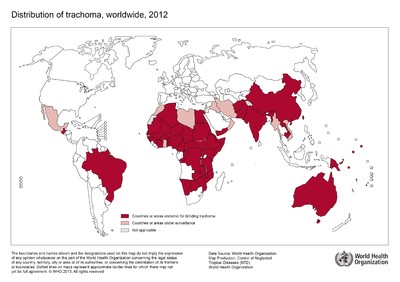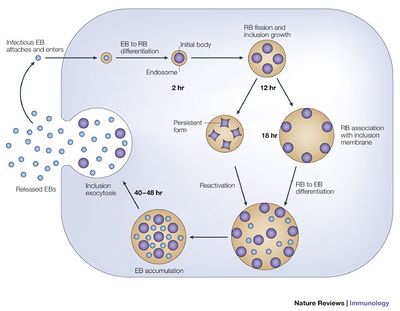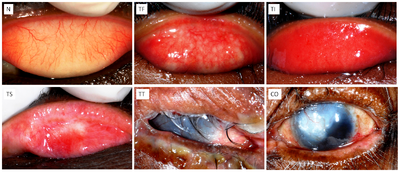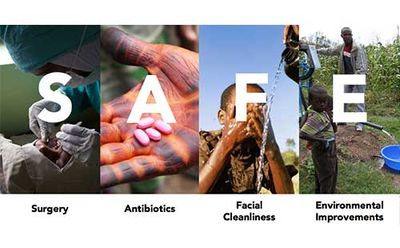Ocular Infection by Chlamydia trachomatis: Public Health Responses to Pathology: Difference between revisions
| Line 4: | Line 4: | ||
<br>By Lydia Wolf<br> | <br>By Lydia Wolf<br> | ||
<br>The World Health Organization estimates ocular infection by the organism <i>Chlamydia trachomatis</i> to affect approximately 1.8 million people worldwide (WHO 2015). Repeated infection by the intracellular parasite, which typically begins during childhood, causes inflammation of the skin epithelium lining the inside of the eyelids called the conjunctiva. The chronic infection and inflammation of the conjunctiva causes the eyelashes of the upper lid to turn in and rub directly against the surface of the cornea. This rubbing against the cornea leads to scarring and, when left untreated by a trachiasis surgical procedure, ultimately leads to blindness…making it the leading cause of infectious blindness worldwide (Kuper, Solomon, Buchan, et al. 2003).<br>The pathogenic organism <i>Chlamydia trachomatis</i> is transmitted through direct personal contact of discharge from the mucous membranes of the eyes and nose, as well as flies that have been in contact with infected membranes, causing trachoma. The bacteria can also be transmitted to a newborn during delivery from a mother with a genital chlamydial infection causing neonatal conjunctivitis (Mabey, Solomon and Foster 2003). Ocular trachoma is especially prevalent in poor and rural developing regions affected by environmental risk factors which include crowded living conditions, and poor water sanitation facilities, as well as limited access to health care. Children and women living in these regions are a population of particular concern, as the family unit is a significant vehicle for transmission by direct contact with previously infected family members.<br> During the early 19th Century, trachoma (although already present in Europe before this time) became prevalent throughout Europe due to close contact between European and Egyptian soldiers during the Napoleonic Wars. Trachoma became an increasing public health concern in Europe following the Napoleonic Wars, and was a concern for the U.S. government regarding European immigration during the early 20th century who maintained strict trachoma inspections before the embarkation of immigrants in Europe (Schlosser 2016). The discovery of trachoma’s causative agent did not occur until around 1907 when the two Austrian | <br>The World Health Organization estimates ocular infection by the organism <i>Chlamydia trachomatis</i> to affect approximately 1.8 million people worldwide (WHO 2015). Repeated infection by the intracellular parasite, which typically begins during childhood, causes inflammation of the skin epithelium lining the inside of the eyelids called the conjunctiva. The chronic infection and inflammation of the conjunctiva causes the eyelashes of the upper lid to turn in and rub directly against the surface of the cornea. This rubbing against the cornea leads to scarring and, when left untreated by a trachiasis surgical procedure, ultimately leads to blindness…making it the leading cause of infectious blindness worldwide (Kuper, Solomon, Buchan, et al. 2003).<br> | ||
<br><b> | |||
The pathogenic organism <i>Chlamydia trachomatis</i> is transmitted through direct personal contact of discharge from the mucous membranes of the eyes and nose, as well as flies that have been in contact with infected membranes, causing trachoma. The bacteria can also be transmitted to a newborn during delivery from a mother with a genital chlamydial infection causing neonatal conjunctivitis (Mabey, Solomon and Foster 2003). Ocular trachoma is especially prevalent in poor and rural developing regions affected by environmental risk factors which include crowded living conditions, and poor water sanitation facilities, as well as limited access to health care. Children and women living in these regions are a population of particular concern, as the family unit is a significant vehicle for transmission by direct contact with previously infected family members.<br> | |||
<br><b> | |||
During the early 19th Century, trachoma (although already present in Europe before this time) became prevalent throughout Europe due to close contact between European and Egyptian soldiers during the Napoleonic Wars. Trachoma became an increasing public health concern in Europe following the Napoleonic Wars, and was a concern for the U.S. government regarding European immigration during the early 20th century who maintained strict trachoma inspections before the embarkation of immigrants in Europe (Schlosser 2016). The discovery of trachoma’s causative agent did not occur until around 1907 when the two Austrian researchers, Halberstaedter and Prowazek, discovered the cytoplasmic inclusion bodies in scrapings from infected patients by staining and light microscopy, which were then used to inoculate the eyes of orangutans showing how the trachoma infection was spread between individuals. Further research following this initial discovery began to link ocular trachoma to newborn conjunctivitis and sexually transmitted infections in the female genital epithelium (Schlosser 2016).<br> | |||
<br><b> | |||
Although no longer a major health concern in Europe or the United States, trachoma remains prevalent in certain endemic regions of the developing world. The World Health Organization estimates the disease to be endemic in approximately 50 nations worldwide across Africa, Asia, and regions of the Middle East with approximately 232 million people living in these areas at risk for infection (WHO 2015). Public health campaigns are being conducted across these regions to meet goals outlined twenty years ago at the 1996 launching of the “WHO Alliance for the Global Elimination of Trachoma by the year 2020” (WHO 2015). The public health response campaigns working towards control and prevention of ocular trachoma, typically implement the WHO recommended “SAFE” strategy consisting of both environmental and medical interventions (Kuper, Solomon, Buchan, et al., 2003).<br> | |||
Revision as of 02:32, 27 April 2016
Introduction and Significance

By Lydia Wolf
The World Health Organization estimates ocular infection by the organism Chlamydia trachomatis to affect approximately 1.8 million people worldwide (WHO 2015). Repeated infection by the intracellular parasite, which typically begins during childhood, causes inflammation of the skin epithelium lining the inside of the eyelids called the conjunctiva. The chronic infection and inflammation of the conjunctiva causes the eyelashes of the upper lid to turn in and rub directly against the surface of the cornea. This rubbing against the cornea leads to scarring and, when left untreated by a trachiasis surgical procedure, ultimately leads to blindness…making it the leading cause of infectious blindness worldwide (Kuper, Solomon, Buchan, et al. 2003).
The pathogenic organism Chlamydia trachomatis is transmitted through direct personal contact of discharge from the mucous membranes of the eyes and nose, as well as flies that have been in contact with infected membranes, causing trachoma. The bacteria can also be transmitted to a newborn during delivery from a mother with a genital chlamydial infection causing neonatal conjunctivitis (Mabey, Solomon and Foster 2003). Ocular trachoma is especially prevalent in poor and rural developing regions affected by environmental risk factors which include crowded living conditions, and poor water sanitation facilities, as well as limited access to health care. Children and women living in these regions are a population of particular concern, as the family unit is a significant vehicle for transmission by direct contact with previously infected family members.
During the early 19th Century, trachoma (although already present in Europe before this time) became prevalent throughout Europe due to close contact between European and Egyptian soldiers during the Napoleonic Wars. Trachoma became an increasing public health concern in Europe following the Napoleonic Wars, and was a concern for the U.S. government regarding European immigration during the early 20th century who maintained strict trachoma inspections before the embarkation of immigrants in Europe (Schlosser 2016). The discovery of trachoma’s causative agent did not occur until around 1907 when the two Austrian researchers, Halberstaedter and Prowazek, discovered the cytoplasmic inclusion bodies in scrapings from infected patients by staining and light microscopy, which were then used to inoculate the eyes of orangutans showing how the trachoma infection was spread between individuals. Further research following this initial discovery began to link ocular trachoma to newborn conjunctivitis and sexually transmitted infections in the female genital epithelium (Schlosser 2016).
Although no longer a major health concern in Europe or the United States, trachoma remains prevalent in certain endemic regions of the developing world. The World Health Organization estimates the disease to be endemic in approximately 50 nations worldwide across Africa, Asia, and regions of the Middle East with approximately 232 million people living in these areas at risk for infection (WHO 2015). Public health campaigns are being conducted across these regions to meet goals outlined twenty years ago at the 1996 launching of the “WHO Alliance for the Global Elimination of Trachoma by the year 2020” (WHO 2015). The public health response campaigns working towards control and prevention of ocular trachoma, typically implement the WHO recommended “SAFE” strategy consisting of both environmental and medical interventions (Kuper, Solomon, Buchan, et al., 2003).
At right is a sample image insertion. It works for any image uploaded anywhere to MicrobeWiki.
The insertion code consists of:
Double brackets: [[
Filename: PHIL_1181_lores.jpg
Thumbnail status: |thumb|
Pixel size: |400px|
Placement on page: |right|
Legend/credit: World Health Organization. (2013). World Health Organization Map Production: Control of Neglected Tropical Diseases (NTD). [5].
Closed double brackets: ]]
Other examples:
Bold
Italic
Subscript: H2O
Superscript: Fe3+
Introduce the topic of your paper. What is your research question? What experiments have addressed your question? Applications for medicine and/or environment?
Sample citations: [1]
[2]
A citation code consists of a hyperlinked reference within "ref" begin and end codes.
Section 1

Include some current research, with at least one figure showing data.
Every point of information REQUIRES CITATION using the citation tool shown above.
Section 2
Include some current research, with at least one figure showing data.
Section 3

Include some current research, with at least one figure showing data.
Section 4

Conclusion
References
Authored for BIOL 238 Microbiology, taught by Joan Slonczewski, 2016, Kenyon College.
